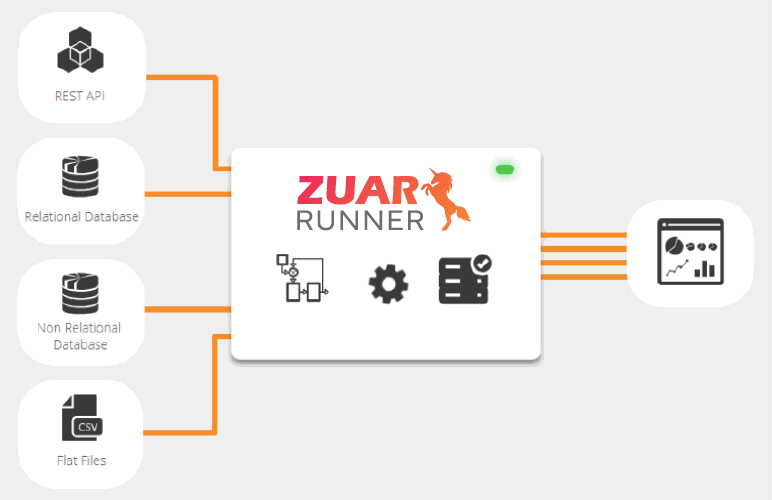What is Amazon Athena?
Zuar explains what Amazon Athena is, it's architecture, its advantages and limitations, how it compares to other AWS services, and its use cases.

Overview
Amazon Athena, a serverless, interactive query service offered by AWS, has garnered attention as a powerful tool for analyzing vast amounts of data stored in Amazon S3.
While it boasts the promise of cost-effective, on-demand querying, it's essential to approach Amazon Athena with a clear understanding of its capabilities, limitations, and the real-world challenges it poses.
In this article, we’ll explore the basics of Amazon Athena, its architecture, and how it compares to other data analysis solutions. While Amazon Athena offers undeniable advantages, it's not a one-size-fits-all solution, and navigating its complexities can be a demanding task.

Amazon Athena: An Interactive Query Service
AWS Athena is a solution suited for organizations looking to analyze data stored in Amazon Simple Storage Service (Amazon S3). This serverless, interactive query service enables users to:
- Run standard SQL queries on various data formats
- Analyze data without managing any underlying infrastructure
- Eliminate the need for complicated server setups or maintenance
Amazon Athena has the ability to handle unstructured, semi-structured, and structured data sets, making it a versatile tool for data analysts.
Access Athena via the AWS Management Console, an API, or a JDBC driver, and you’re all set to query data from Amazon S3. With its pay-per-query pricing model, you only pay for the queries you run. However, this can lead to unpredictable costs if not properly managed.
This service provides API access, saved queries, and other features found in databases such as RDS-managed MySQL or Microsoft SQL Server.

Delving into Amazon Athena's Architecture
Amazon Athena’s architecture is built on three main pillars: a serverless design, a distributed SQL query engine, and seamless integration with other AWS services.
This architecture allows for efficient querying of data stored in Amazon S3, including data processed by other AWS services, without the need for complicated infrastructure management.
We will now examine each of these components in detail.
Serverless Design
Amazon Athena’s serverless design is a good option for data analysts who want to focus on extracting insights rather than managing infrastructure.
The serverless nature of Athena means that it automatically scales with the amount of data being queried. This design eliminates the need for users to manage infrastructure, and Athena can scale resources as necessary to handle query loads.
It charges based on the amount of data scanned, however, which can become costly for extensive or complex queries.
Distributed SQL Query Engine
At the heart of Amazon Athena’s capabilities is its distributed SQL query engine, which is based on Presto.
This engine allows for querying of data stored in Amazon S3, even when dealing with large, complex data sets, including the ability to query encrypted data in the underlying data store.
Athena’s compatibility with Presto and Trino ensures that it can integrate with open-source frameworks, making it versatile for a number of use cases—whether their data is structured or unstructured.
Integration with AWS Services
To further enhance its capabilities, Amazon Athena can be integrated with other AWS services, such as AWS Glue Data Catalog and Amazon QuickSight.
These integrations maximize Athena’s functionality and also allow users to leverage the full power of the AWS ecosystem.
Athena Data Source Connectors
Amazon Athena also offers a number of prebuilt data source connectors. This makes it easier to access and analyze data from a wide range of sources without the need to manually transfer or load data into Athena.
These connectors simplify the process of querying data from various sources by making the data appear as if it were stored in a single database, even if the data is distributed across multiple services or locations.
There are limitations to these data source connectors, however, including a limited number of supported data sources and variability in performance.
If your aim is to integrate data from multiple sources, consider implementing an automated data pipeline solution like Zuar Runner. This end-to-end ELT platform can collect and prepare data from a variety of disparate sources and centralize them in a single location. Learn more about Zuar Runner...


Advantages of Amazon Athena
Adopting Amazon Athena offers a number of benefits. Its serverless architecture enables rapid querying of data without the need for infrastructure management, making it an attractive option for organizations looking to reduce IT overhead.
Moreover, Amazon Athena:
- Is cost-efficient
- Supports a wide range of data formats
- Provides fast access to data
- Has seamless integration with other AWS services
These features make distributed data processing frameworks a powerful and versatile tool for data analysts, especially when dealing with data scanned from various sources.

Amazon Athena Limitations
While Amazon Athena is an impressive and relatively inexpensive query service, it does come with some limitations, including:
- Cost Unpredictability: The pay-per-query model in Athena has its pros and cons. On one hand, it offers flexibility, but if your queries aren't finely tuned, or if your partitioning strategy isn't well-planned, it can work against you. Furthermore, in the absence of query optimization and a sound partitioning strategy, you may inadvertently query data you don't need, ultimately incurring unnecessary expenses.
- Performance Inconsistency: Athena operates without the provision of exclusive resources. Instead, your queries draw from a shared resource pool with fellow users within the same AWS region. Consequently, it may not be the most suitable choice for applications demanding immediate, real-time outcomes.
- Optimization Limitations: Optimization is constrained just to queries; data that is already stored in S3 cannot be further optimized.

Enhancing Amazon Athena with Complementary AWS Services
The aforementioned integrations, AWS Glue Data Catalog and Amazon QuickSight, are two complementary AWS services that can enhance Amazon Athena’s capabilities.
We will now delve into these services for a better understanding.
AWS Glue Data Catalog
AWS Glue Data Catalog is an essential service for managing metadata and schema information for Amazon Athena. By creating a unified metadata repository across multiple services, AWS Glue Data Catalog streamlines data access and querying for Athena users.
AWS Glue includes crawlers that can automatically scan data sources to detect schemas, populating the Catalog with new and modified table and partition definitions, and maintaining schema versioning.
This integration between Amazon Athena and AWS Glue Data Catalog simplifies metadata management and enhances the overall data analysis experience.
Additionally, AWS Lake Formation provides a complete data governance solution for the Glue Catalog with fine-grained access controls down to the row and column level and query auditing capabilities.
Learn more about AWS Glue...

Amazon QuickSight
Amazon QuickSight is another data visualization tool that integrates with Amazon Athena.
This cloud-native, serverless business intelligence (BI) service offers native machine learning (ML) integrations and usage-based pricing, making it an attractive option for organizations seeking rapid insights from their data.
With Amazon QuickSight, users can:
- Create interactive dashboards and reports from data stored in Amazon Athena
- Visualize and understand the data being analyzed
- Enhance the data analysis process
- Empower users to make data-driven decisions with confidence
However, QuickSight's data transformation capabilities are not as robust as dedicated ETL/ELT tools, like Zuar Runner. Complex data preparation tasks may need to be handled outside of QuickSight.

Real-World Use Cases of Amazon Athena
Some of the real-world use cases for Amazon Athena include log analysis, data transformation, and ad-hoc data exploration.
For example, ClearScale, an AWS Premier Consulting Partner, implemented Amazon Athena for their client, resulting in significant operational cost reductions and improved data analysis capabilities.
With Amazon Athena at the heart of their data lake, organizations can address a wide range of data analysis needs, making it a good solution for many data analysts.

Optimizing Amazon Athena Performance and Cost
Maximizing Amazon Athena’s performance and cost-effectiveness is key to fully utilizing this query service. Without data partitioning, compression techniques, and format conversion, Athena's costs may be unpredictable and higher than expected.
We will now examine each of these techniques in detail.
Data Partitioning
Data partitioning is a technique employed to divide a large dataset into smaller, more manageable portions or subsets.
By splitting the data based on column values such as date or timestamps, partitioning can help reduce the amount of data that Athena needs to scan to execute a query, thereby improving performance and cutting costs.
Partitioning your data boosts query performance and also enhances scalability and efficiency, as data can be stored in various locations or in different types of data stores.
Compression Techniques
Compression techniques are another way to optimize Amazon Athena’s performance and cost. By reducing the size of data stored using GZIP, Snappy, or LZO compression, you can minimize the amount of data that Athena needs to scan to execute a query.
Implementing compression improves query performance and reduces storage costs, making Amazon Athena a more affordable option for data analysts.
Format Conversion
Format conversion is another technique that can improve Amazon Athena’s performance and cost. By converting data to standard data formats, such as columnar formats like Apache Parquet or Apache ORC, you can expedite query time and reduce expenses.
Transforming data from one format to another, such as from CSV to Apache Parquet, can have a considerable impact on query performance and cost savings.
By optimizing the format of your data, you can ensure that your Amazon Athena queries run efficiently.

Comparing Amazon Athena with Other Data Analysis Solutions
Amazon Athena can be compared with other data analysis solutions like Microsoft SQL Server, Amazon Redshift, and ETL/ELT platforms, each having its own strengths and weaknesses.
In this section, we will analyze how Amazon Athena compares to these three data analysis solutions.
Amazon Athena vs. Microsoft SQL Server
When comparing Amazon Athena and Microsoft SQL Server, it’s important to consider their differences in terms of infrastructure requirements, scalability, and cost structure.
Amazon Athena is a serverless query engine that does not require server installation, unlike Microsoft SQL Server, a traditional database management system that does require server installation.
In terms of scalability, Amazon Athena provides automatic scalability, whereas Microsoft SQL Server requires manual configuration.
Additionally, Athena follows a pay-per-query pricing model, while SQL Server typically requires a licensing fee. These differences make each solution more suitable for specific use cases and organizational needs.
Amazon Athena vs. Amazon Redshift
Comparing Amazon Athena with Amazon Redshift reveals that they serve different purposes within the data analysis landscape.
Amazon Athena is a serverless query service designed for ad-hoc data exploration, while Amazon Redshift is a data warehousing platform that consolidates data from multiple sources into a single format and processes more complex, multipart SQL queries.
Redshift also has an Athena-like service called Redshift Spectrum; this can be used to query the Glue catalog like Athena does and can be very useful, allowing you to integrate your Athena data lake with your Redshift data warehouse.
Amazon Athena vs. ETL/ELT Platform
Amazon Athena is a serverless query service for ad-hoc, interactive querying of data in Amazon S3, well-suited for scenarios where data requires minimal preparation.
In contrast, ETL/ELT platforms like Zuar Runner are designed for data integration, transformation, and loading, making them ideal for scheduled, batch-oriented processing and comprehensive data preparation.
The choice between Amazon Athena and an ETL platform hinges on your specific use case. If you require immediate, on-demand access to data already stored in Amazon S3 and minimal data preparation, Athena is a suitable choice. Conversely, if you need extensive data integration, transformation, and scheduled processing, an ETL/ELT platform is the preferred option.

Enhance Your AWS Data Architecture
Amazon Athena is a serverless, interactive query service that simplifies data analysis by eliminating the need for complex infrastructure management. But how can it fit in with your current data architecture? Is it the best solution for your organization?
Navigating the terrain of the AWS landscape can be a tricky task when it comes to building your data architecture. That's why we recommend consulting with data experts, like our data team at Zuar, to ensure that you build a robust, scalable data architecture.
Zuar also has solutions that can enhance your data stack. Our automated data pipeline platform Zuar Runner, can create a single source of truth for all your disparate data.
Our data portal solution, Zuar Portal, can be used to securely share your data insights with all your stakeholders. With simple drag-and-drop features, you can easily build your analytics HQ, fully customized to match company branding.
Learn more about our services and solutions by scheduling a data strategy assessment with one of our friendly data experts!




